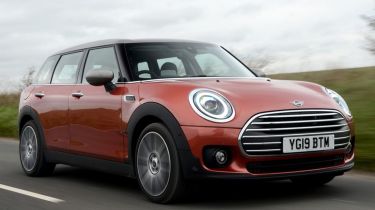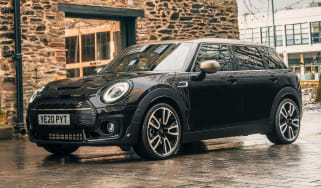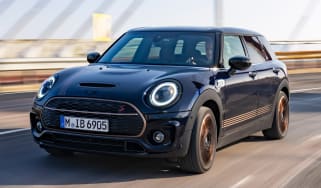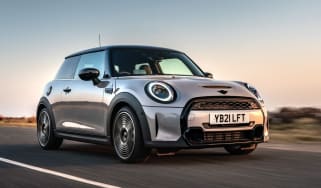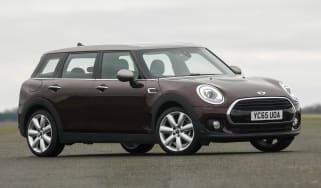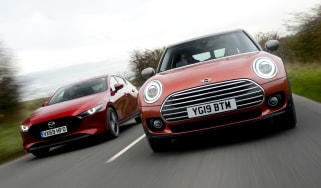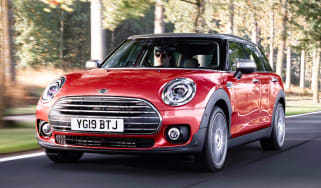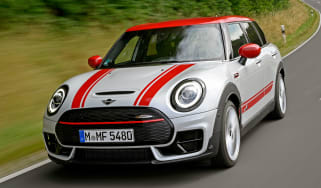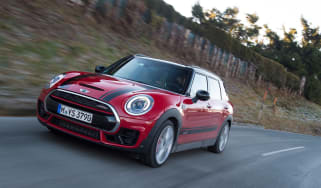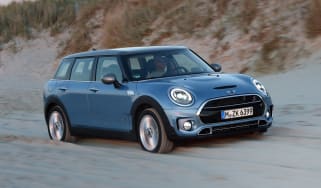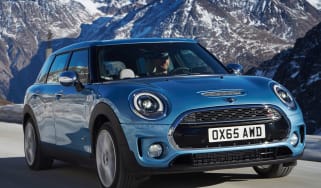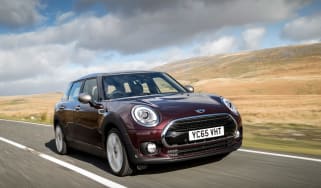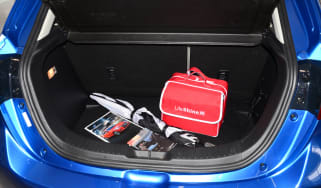MINI Clubman (2015-2024) review
The MINI Clubman is a fun, small estate that's well-built and powered by a great range of engines – but it's not that practical

Just so you know, this is an older review of the 2015-2024 MINI Clubman. If you are interested in information about a used MINI Clubman, or news about the latest MINI models, please follow the links provided.
The MINI Clubman is a niche offering that’s better considered alongside premium hatchbacks than conventional small estates. It is a MINI that can genuinely be used as a proper family car, all the while retaining much of what makes smaller MINI models so great to drive.
Strong engines and an engaging, composed chassis are highlights, while refinement and comfort are impressive. Many will be sold on looks alone; the Clubman is a great car all-round.
About the MINI Clubman
The MINI Clubman on sale today uses a name from the classic Mini archive, and it has plenty of retro design cues, but there are also plenty of modern touches onboard. While the Clubman is essentially an estate version of the standard MINI five-door, it doesn’t offer the same levels of practicality as a traditionally-shaped estate car. Instead, it’s best thought of as a quirkily designed large hatchback, with its unique double rear door arrangement offering improved accessibility and space.
The Clubman received an update in 2019 that added refreshed looks, Union Jack tail lights, and a simplified trim range. The performance JCW model also received the same 302bhp engine used in the BMW M135i.
Used - available now

2026 Volkswagen
Polo
5,542 milesManualPetrol1.0L
Cash £16,000
2021 DS
DS 3 CROSSBACK E-TENSE
18,985 milesAutomaticElectric
Cash £11,400
2020 Audi
A3 Sportback
32,700 milesManualPetrol1.5L
Cash £16,400
2023 Volkswagen
ID.4
36,736 milesAutomaticElectric
Cash £20,200For the rest of the range, power comes courtesy of two petrol engines. A 1.5-litre three-cylinder features in the Cooper with 134bhp, while a 2.0-litre four-cylinder unit appears in the Cooper S with 176bhp. Front-wheel drive is standard across the range, while the four-wheel drive Clubman ALL4 is no longer available.
Each of these engines can be had in combination with one of three trims – Classic, Sport or Exclusive. These packs largely affect styling and interior trim, along with basic standard equipment. Classic is the entry point with minimal extras and 16 or 17-inch alloys depending on engine, Sport brings some racier styling plus 18-inch alloys, cruise control, parking sensors and sport suspension, while Exclusive cars get lots of leather trim plus cruise control and 18-inch alloys.
Engines, performance and drive
Despite its stretched-out dimensions, the Clubman still steers with the same enthusiasm as the MINI hatch. This eager character is a trait all MINIs possess, from the Convertible to the Countryman crossover.
The steering still has the same sharp feeling as on the MINI hatch, although it does feel a little light for our tastes. However, it responds keenly to fast changes in direction and never feels like it’s being asked to do something out of its remit. While the Clubman still resonates with that classic MINI feel, the engineers have really focused on is refinement and ride quality.
In the past, MINIs have been about as famous for their poor ride quality as for their engaging character, but the British brand has addressed that with the Clubman. It feels softer than any past MINIs and you can really feel that on the road.
Hit a bump and the Clubman feels composed when dealing with poor road surfaces. It's still firm compared to a Volkswagen Golf, but never uncomfortable.
Engines, 0-60 acceleration and top speed
The Clubman Cooper has a 134bhp 1.5-litre petrol, offering enough performance for most needs, along with a surprising amount of torque and decent efficiency. With a 0-62mph time of 9.2 seconds, it's more than adept at maintaining MINI's reputation for building nippy cars.
The more expensive 176bhp Cooper S isn't significantly more exciting, and doesn't sound or feel as fast as the hatchback version, although it does get a useful slug of extra torque from its larger 2.0-litre engine.
The Clubman John Cooper Works provides the thrills in the range, using the same 2.0-litre 302bhp four-cylinder turbo engine that drives the BMW M135i. This means a 0-62mph time of only 4.9 seconds, along with a top speed of 155mph - proper hot hatch numbers.
MPG, CO2 and running costs
The Clubman is around £4,000 more expensive than the five-door MINI hatchback, but it’s worth remembering that the Clubman is a rival for the Volkswagen Golf, so is priced to compete with a larger class of car. Most buyers are likely to go for the petrol Cooper which returns up to 47.1mpg on the WLTP combined cycle, and emits 141g/km.
An eight-speed auto adds a premium to the Clubman's price, but it does help to return slightly better fuel economy. It’s a particularly effective unit that’s smooth and boasts quick changes, so if you’re doing a lot of urban driving, it may be worth the extra outlay.
Those after greater performance are well catered for by the Cooper S. It's powered by a 176bhp 2.0-litre four-cylinder turbo, which propels it from 0-62mph in 7.2 seconds and returns up to 42.2mpg, or up to 44.8mpg for the auto version. Buyers opting for the hardcore John Cooper Works model still benefit from average economy of up to 38.2mpg, although this may be a touch optimistic if you choose to exploit the full JCW performance on a regular basis.
Insurance groups
With modest power outputs and reasonable list prices, the Clubman attracts relatively low insurance groups. The range starts in group 20 for a Cooper, climbing to group 26 for Cooper S models. The powerful JCW model occupies group 40 and will be considerably more expensive to insure than other models in the range.
Depreciation
MINIs typically have strong residual values, but the Clubman's depreciation can vary depending on how you specify it. Over an average ownership period of three years and 36k miles, you can expect the Clubman to retain an average of 50 per cent of its original value.
To get an accurate valuation on a specific model check out our free car valuation tool...
Interior, design and technology
From the A-pillars forward, the Clubman is identical to the five-door hatchback on which it's based. From that point backwards, the love-it-or-hate-it shooting brake body style is unique. It looks like an estate but proportionally it’s the size of a hatchback and is designed to look far more mainstream than the old Clubman model with its rear-hinged ‘club door’ on one side of the car.
Inside, the dashboard is pure MINI and it gets a unique design over the standard hatchback to mark it out as the more premium model, these include an LED trimmed centre display and fighter jet-style toggle switches.
Below the centre console is a handy storage compartment, two USB plugs and two large cupholders ahead of the gearstick. The centre armrest can be folded up out of the way and can also be specced with an integrated mobile phone compartment.
Sat-nav, stereo and infotainment
As MINI is owned by BMW, this means that it can take advantage of the iDrive infotainment system. This system is used in the Clubman and is operated via an intuitive swivel wheel on the centre console.
The lack of a touchscreen isn’t as frustrating as it may initially seem, though, as this system is easy to use and doesn’t suffer from fingerprint smudges on the screen. All models get an 8.8-inch screen, serving as a display for infotainment, phone and navigation functions. Apple CarPlay is included but there's no support for Android Auto.
Practicality, comfort and boot space
The MINI Clubman is 270mm longer than the five-door hatchback, while the wheelbase is also 100mm longer, which adds much-needed legroom in the back. The ditching of the first Clubman's single ‘club door’ in favour of two conventional rear doors makes access to the rear seats far easier, although they don’t look quite as cool. The switch to the more orthodox design also opens up the Clubman to a whole new batch of potential buyers who may be considering a mainstream hatch like the VW Golf, Peugeot 308 or SEAT Leon.
Another area of improvement is the boot. While boot space in the Clubman is still not huge at 360 litres, it's 20 litres bigger than the old car. Access is also very impressive thanks to the split rear barn doors which open via a touch sensitive button hidden behind the chrome door handles. Just like a van, they only open one way, so you have to close the left-hand door before closing and locking the right-hand door. Fold the rear seats down and there’s 1,250 litres of space to play with.
If you spec MINI’s Comfort Access option, a simple kick of your foot under the rear bumper opens the boot – ideal if you have hands full of shopping. One drawback is that while the van-like rear doors are easy to use, they do restrict rear visibility when you’re on the move.
Dimensions and size
The Clubman measures in at just under 4,300mm long and 1,800mm wide, which makes it 270mm longer and 73mm wider than the MINI 5-door Hatch. The wheelbase is also 100mm longer.
Proportionally that makes it slightly longer and wider than a VW Golf, but it is more compact than the Vauxhall Astra.
Leg room, head room & passenger space
The gain in size over the MINI Hatch will be immediately noticeable to those sitting in the Clubman. Not only is access to the rear greatly improved, but leg and headroom is also now on par with the Audi A3. Two adults will be more than comfortable in the back, but you can squeeze three in if you need to. If space is a priority then the Clubman won't really be for you, and you'll get better value by choosing the latest compact hatch-based estates.
Boot space
The 360-litre boot is a decent shape and with flat sides and a reasonable load lip, although that boot capacity isn't really outstanding. Drop the rear seats and space increases to 1,250 litres and the rear bench sits flush with the boot floor so sliding in longer, heavier items won’t be too much of a chore.
Reliability and safety
The MINI Clubman scored a four-star safety rating when Euro NCAP tested it in 2015, which means it trails most of its main rivals. While the Clubman scored well for the protection it affords adult occupants (90 per cent), its 68 per cent pedestrian protection and child occupant scores let it down slightly, while a 67 per cent score for safety tech isn't that great, either.
The Clubman does benefit from BMW's excellent build quality, plus the materials used are all superb. Front and side airbags come as standard, as do curtain airbags which extend all the way back in the Clubman to account for its increased length.
While the Clubman sells in too few numbers to appear in our Driver Power survey, the standard hatch frequently appears, and this ranked as the 26th best car to own (out of 75) in 2023.
Warranty
The Clubman, like the rest of MINI's range, gets the same three-year unlimited-mileage warranty that parent company BMW provides with all its new cars. This is slightly better than some rivals, which put a mileage limit on the warranty cover.
Servicing
MINI offers its Service Inclusive pack on the Clubman, which costs £836 and covers servicing for five years or 62,000 miles.
Service intervals on the Clubman are determined by the on-board electronics, which show the status of components and fluids via the central display. This should work out to an annual service, although a light on the dashboard and message on the trip computer will advise when a service is necessary.
Mini Clumban alternatives
In terms of rivals, the MINI Clubman doesn't really have any direct competition. If you want a small estate, then there's not much choice this side of the Skoda Fabia Estate, or larger estate versions of hatchbacks. But all of these cars – including the Fabia – will have far bigger boots. Instead, we'd recommend focusing on the premium quality of the Clubman. In that regard, the Clubman is a retro-styled alternative to hatchbacks such as the Volkswagen Golf, Audi A3 or even the closely related BMW 1 Series.

